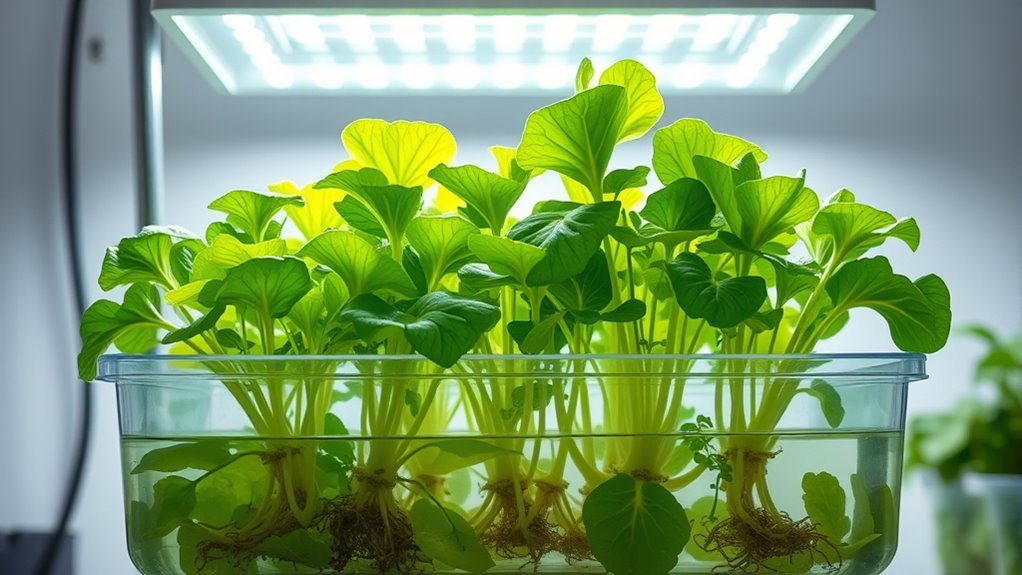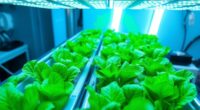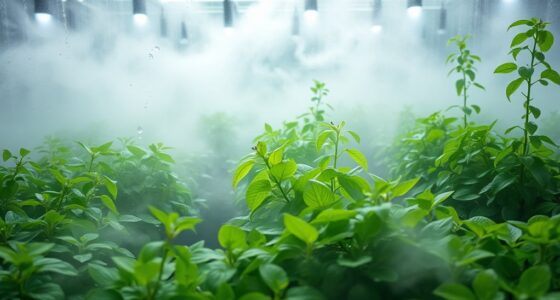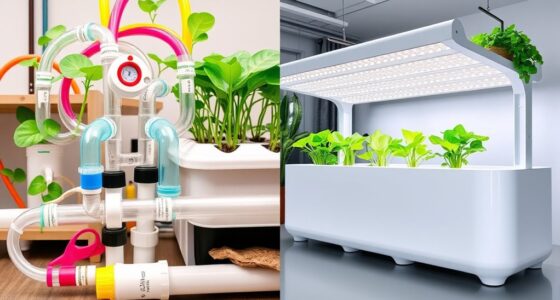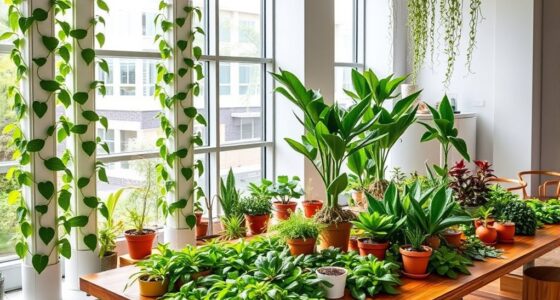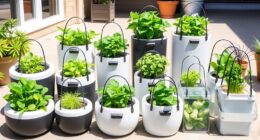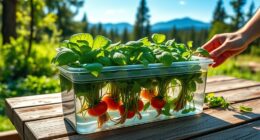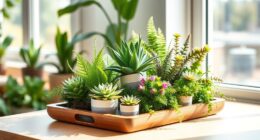The Kratky method hydroponics is an easy, soil-free way to grow plants using passive nutrient solutions in containers. You don’t need pumps, tubing, or electricity, making it simple and cost-effective. It works best for leafy greens, herbs, and small vegetables, with minimal maintenance. If you’re looking for an eco-friendly, low-cost gardening method that’s accessible for beginners, you’ll find more helpful insights further on.
Key Takeaways
- The Kratky method is a passive, soil-free hydroponic system that uses nutrient solutions and gravity for plant root oxygenation.
- It’s ideal for small-scale gardening, beginner growers, and growing fast-growing crops like leafy greens and herbs.
- The system requires minimal equipment, low maintenance, and promotes sustainable, eco-friendly gardening practices.
- It’s simple to set up but needs regular monitoring of water levels and nutrient concentration for healthy plant growth.
- Suitable for hobbyists seeking low-cost, low-effort gardening, though larger or long-term crops may need more advanced systems.
Understanding the Basics of the Kratky Technique
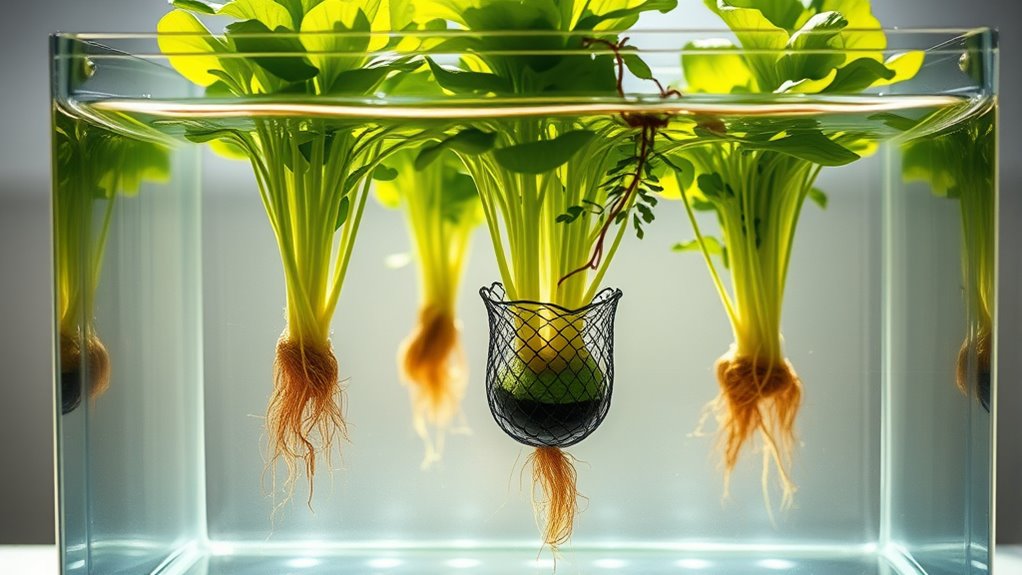
The Kratky method is a simple, soil-free way to grow plants using passive hydroponics. It involves suspending your plants in a container filled with nutrient solutions, which provide all essential nutrients directly to the roots. Unlike other systems, it doesn’t require pumps or aeration, making it low maintenance. While aquaponic integration isn’t typically part of the basic Kratky setup, some growers experiment with combining fish waste with nutrient solutions for a more sustainable approach. The key is ensuring the nutrient solution remains at the right level to keep roots submerged without waterlogging. As the plants grow, the water level drops, creating an air gap that supplies oxygen. This straightforward process allows plants to thrive with minimal intervention, perfect for beginners. Additionally, understanding climate control factors, such as maintaining appropriate temperature and humidity, can further optimize plant growth in hydroponic systems.
How the Kratky Method Differs From Other Hydroponic Systems
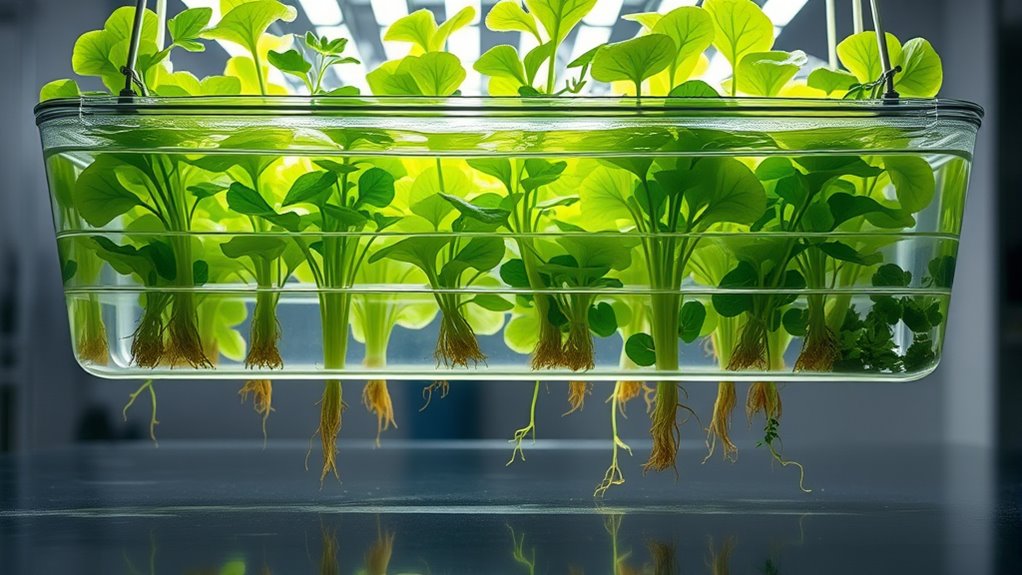
Unlike most hydroponic systems, the Kratky method requires no pumps, tubing, or aerators, making it a simpler, more passive approach. This sets it apart from aeroponics or NFT systems, which rely on active water circulation. because it’s passive, it promotes organic compatibility, allowing you to grow with fewer synthetic inputs. While other systems often emphasize aquaponic synergy—integrating fish and plants—the Kratky method focuses on minimal intervention, making it easier for beginners. It’s ideal if you want straightforward, low-maintenance growth without sacrificing healthy plant development. Its simplicity also means fewer mechanical failures and less equipment. in essence, the Kratky method offers a more natural, organic-friendly option, emphasizing ease and sustainability over complex automation.
Setting Up Your First Kratky Hydroponic System
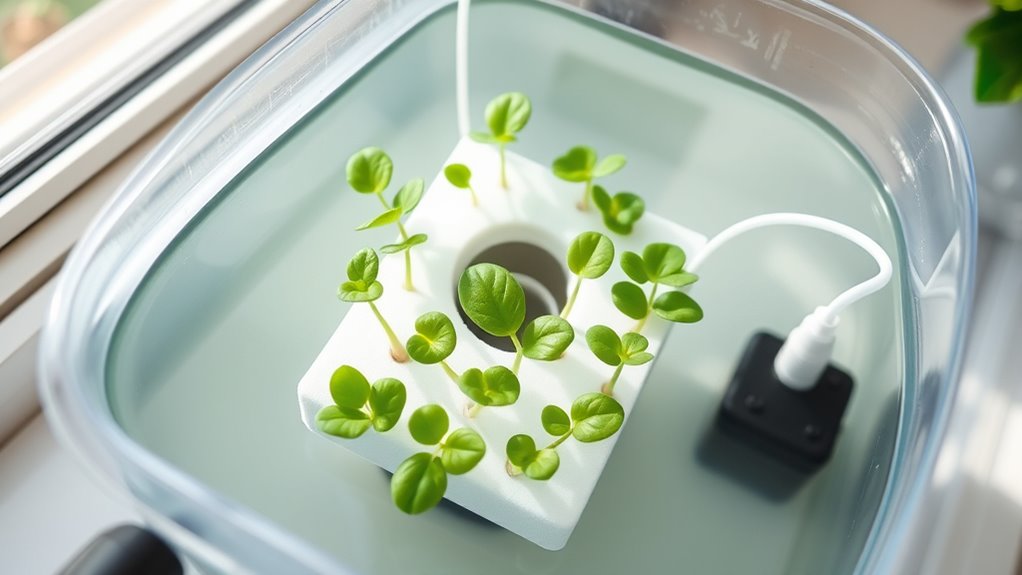
To start your first Kratky system, you need to select a suitable container that holds enough water and fits your space. Next, assemble the components by placing the net pots and ensuring the nutrient solution is at the right level. Once these steps are complete, you’re ready to move on to planting and maintaining your system. Remember to monitor the nutrient levels regularly to ensure optimal plant growth.
Choosing the Right Container
Choosing the right container is essential for a successful Kratky hydroponic system. You want a container that’s sturdy, opaque, and appropriately sized for your plants’ root growth. It should hold enough water and nutrients without overflowing or drying out too quickly. Since soil nutrients aren’t involved, your focus is on maintaining proper watering frequency through the water level. A good container prevents light from reaching the roots, which helps avoid algae growth. Plastic tubs or buckets work well, but ensure they’re food-grade. The size depends on your plant type, but too large can make managing water levels tricky. Remember, the container’s shape and material influence how easily you can monitor and adjust water levels for ideal plant health. Regular maintenance and understanding indoor air quality can also help create a healthier environment for your plants.
Assembling the System
Setting up your first Kratky hydroponic system is straightforward when you have all the necessary components ready. Start by placing your container in a stable spot with adequate light. Fill it with nutrient solutions tailored to your plants’ needs, ensuring you’ve prepared the right concentration. Before inserting the net pots, check the pH level of your nutrient solution; it should typically be between 5.5 and 6.5. Adjust the pH as needed using pH up or down solutions for *ideal* nutrient absorption. Position the net pots so their bottoms just touch the nutrient solution, leaving space for air to reach the roots. Double-check that the water level allows roots to hang freely while maintaining contact with the nutrients. Using the correct growing medium can help support the roots and improve stability once the system is running. Once everything is set, you’re ready to start growing.
Best Crops to Grow Using the Kratky Approach
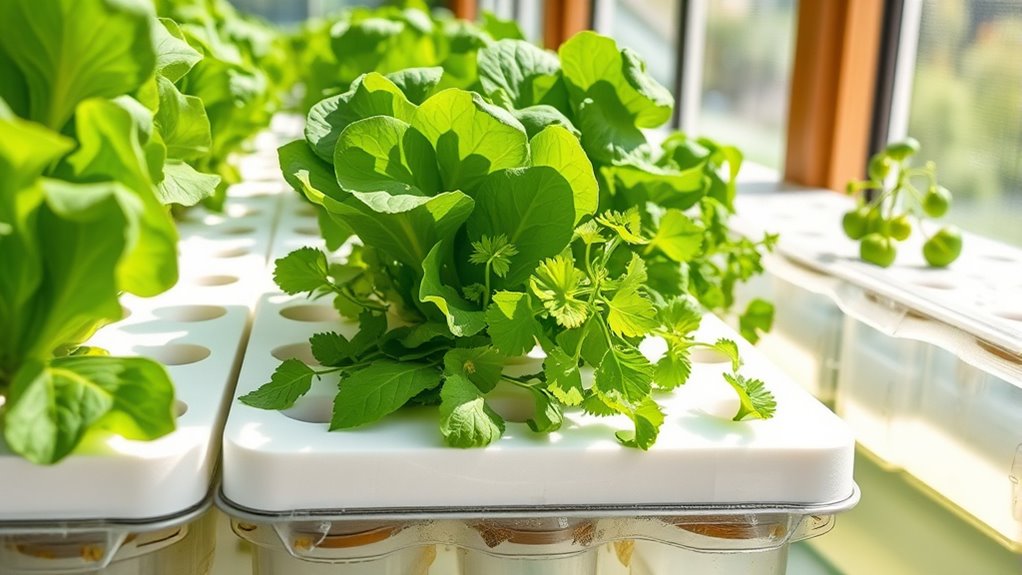
The Kratky method works best with crops that develop roots easily and quickly. These plants thrive in small spaces, making them ideal for compact setups. If you’re looking for simple, space-efficient options, certain vegetables and herbs are excellent choices. Additionally, selecting crops with rapid growth rates can help maximize your harvests and efficiency.
Easy Root Development
Because the Kratky method relies on simple, passive hydroponic setups, some crops develop roots more easily than others. Root development depends heavily on plant nutrition and root aeration, which are naturally optimized in this method. Crops with fast-growing, adaptable roots thrive, making them ideal for beginners. To understand this better, consider the following:
| Crop Type | Root Growth Speed | Nutritional Needs |
|---|---|---|
| Leafy Greens | Fast | Moderate |
| Herbs | Moderate | Low to Moderate |
| Fruit Vegetables | Slow | High |
Choosing crops with quick, healthy root development ensures better oxygen access and nutrient uptake, leading to vibrant growth with minimal effort. Additionally, understanding contrast ratio can help optimize your hydroponic setup’s lighting conditions for healthier plant development.
Suitable for Small Spaces
Looking to maximize your limited space with minimal effort? The Kratky method is perfect for small areas because it requires minimal equipment and space. You can set up vertical containers or small trays that fit easily on windowsills, balconies, or compact indoor gardens. Since water management is straightforward—just fill the reservoir and monitor water levels—you won’t need complex systems. Many crops thrive in these conditions, including lettuce, herbs, spinach, and small peppers. These plants benefit from proper plant nutrition, which is simple to maintain with liquid fertilizers. The Kratky approach allows you to grow fresh produce without the need for large gardens or extensive setup, making it an excellent choice for apartment dwellers or those with limited outdoor space.
Advantages of Using the Kratky Method for Gardening
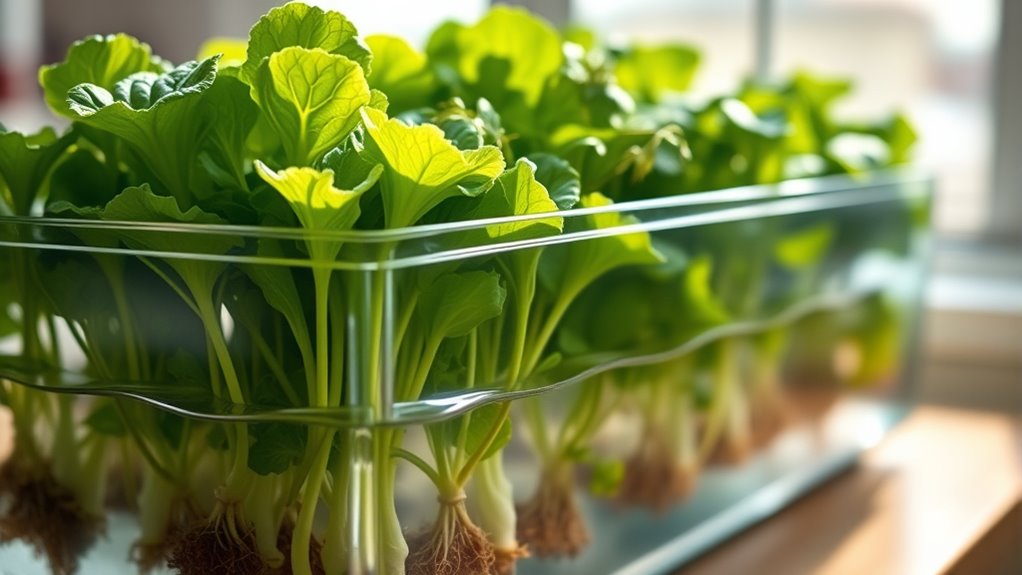
One major advantage of the Kratky method is its simplicity, making it accessible for gardeners of all skill levels. Since it requires minimal equipment and maintenance, you can focus more on enjoying gardening rather than managing complex systems. This method also promotes healthier soil by reducing the need for soil amendments, which can sometimes introduce pests or diseases. With no soil to disturb, pest management becomes easier because you avoid common soil-borne pests and pathogens. Additionally, the controlled environment minimizes pest problems, cutting down on chemical use. An added benefit is the availability of crochet styles for locs that can be used to create protective coverings for your plants, providing extra shield against pests and environmental stressors. Overall, the Kratky method offers a straightforward, low-maintenance way to grow healthy plants while protecting soil health and reducing pest issues. It’s an efficient choice for both beginners and experienced gardeners alike.
Potential Challenges and Limitations of the Kratky System
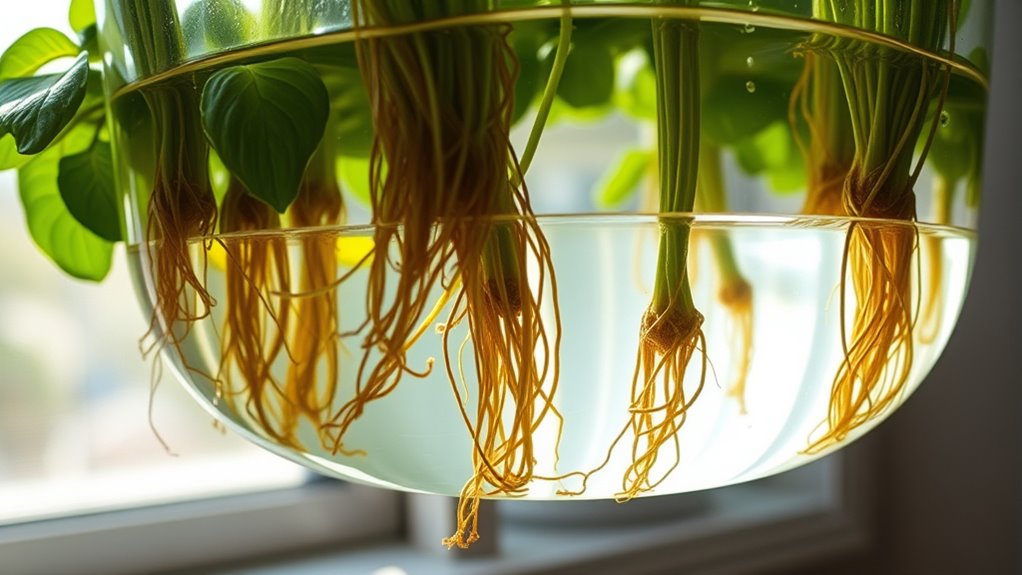
While the Kratky method offers simplicity and convenience, it also presents certain challenges that you should consider. Pest management can be tricky since plants are exposed and may attract pests without the protective barriers found in soil. You’ll need to monitor plants regularly for pests and act quickly to prevent infestations. Nutrient deficiencies are another concern because this system relies on a fixed nutrient solution that can deplete over time. If you don’t check and replenish nutrients, your plants may suffer from deficiencies, affecting growth and yield. Additionally, the system isn’t ideal for larger or longer-growing plants, which may require more precise control over growing conditions. Being aware of these limitations helps you troubleshoot effectively and ensures healthier, more successful hydroponic gardening.
Tips for Maintaining Healthy Plants in a Kratky System
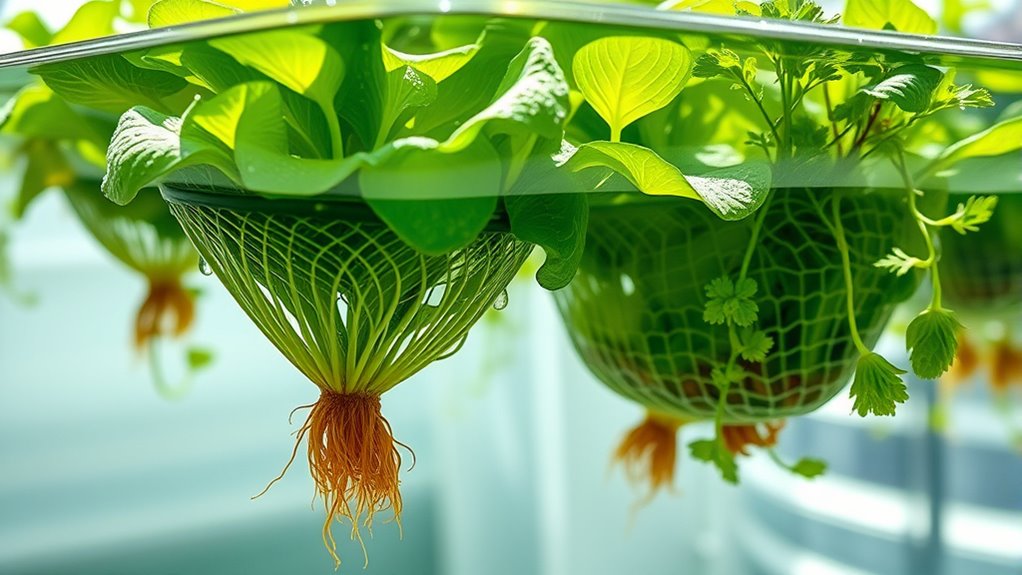
Maintaining healthy plants in a Kratky system requires regular attention and proactive care. Proper fertilizer management guarantees your plants receive essential nutrients without overdoing it, which can lead to issues like nutrient imbalance. Monitoring water levels and adjusting as needed keeps roots submerged just enough for maximum growth. Pest control is vital—inspect plants frequently and remove pests early before they spread. Use organic methods or natural repellents to prevent infestations without harming your plants. Keep a close eye on plant health and adjust nutrient solutions accordingly. Here’s a quick reference:
| Tip | Action |
|---|---|
| Fertilizer Management | Regularly check and adjust nutrient levels |
| Water Levels | Maintain consistent water height |
| Pest Control | Inspect and remove pests promptly |
| Light & Temperature | Ensure proper light and temperature |
| Root Health | Prevent root rot with clean water |
Comparing Costs and Resources Needed for Kratky and Other Methods
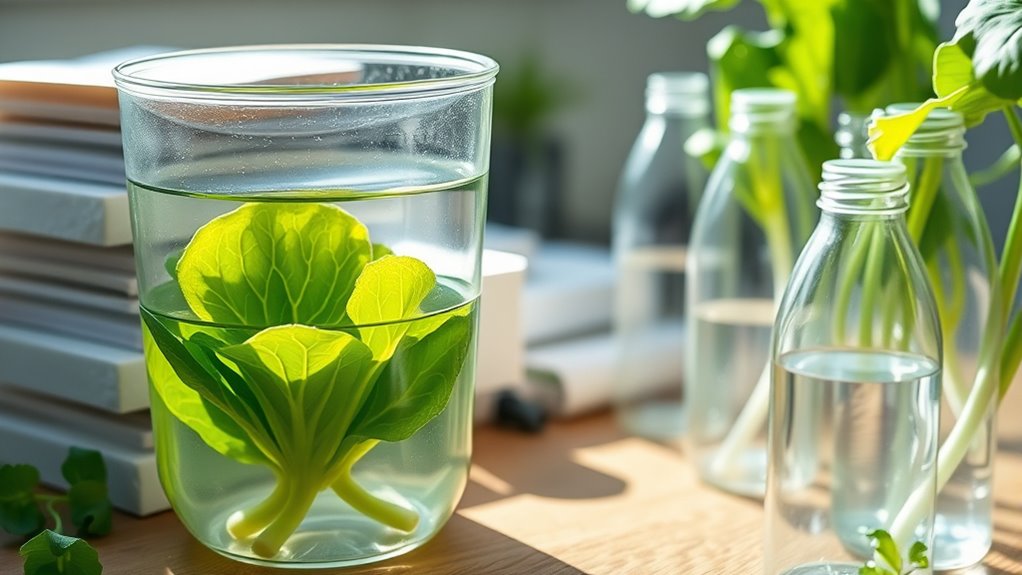
When comparing costs and resources needed for Kratky hydroponics versus other growing methods, you’ll find that Kratky systems generally require less initial investment and fewer ongoing supplies. The cost comparison shows that you won’t need pumps, aerators, or complex plumbing, saving you money upfront. Additionally, the resource efficiency of Kratky means minimal water and nutrient use, reducing ongoing expenses. Unlike drip or flood-and-drain systems, Kratky needs only a simple container, a grow tray, and some net pots, making it accessible and affordable. This simplicity also means fewer maintenance tasks and less need for replacement parts. Furthermore, the minimal resource consumption of Kratky contributes to its sustainability and cost-effectiveness. Overall, Kratky offers a cost-effective and resource-efficient approach, especially for small-scale or beginner growers aiming to keep expenses low.
Is the Kratky Method Suitable for Your Gardening Goals?
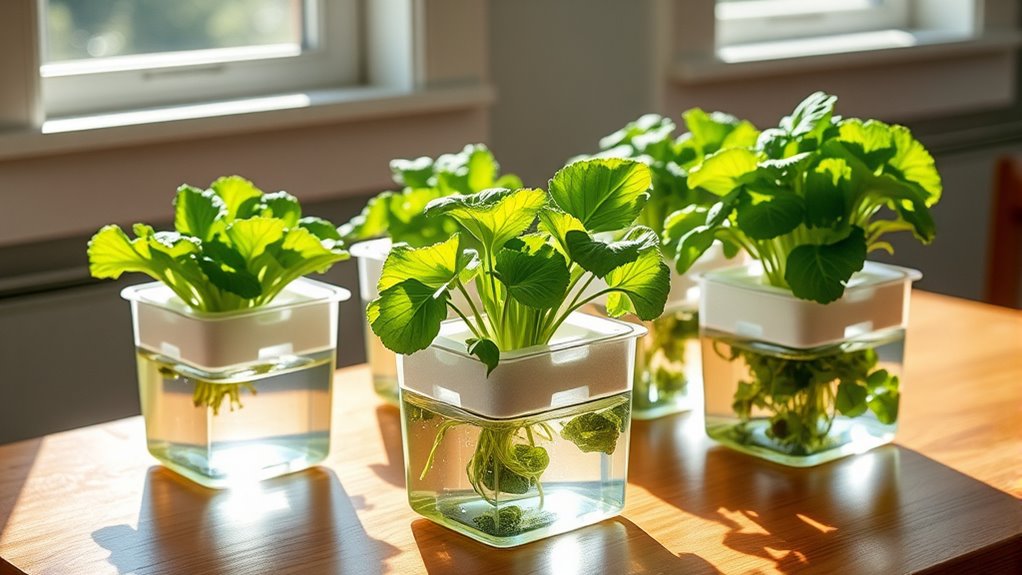
The Kratky Method can be an excellent choice if your gardening goals focus on simplicity, low cost, and minimal maintenance. It aligns well with sustainable practices since it requires little energy or resource input, making it eco-friendly. If you prefer avoiding chemical pest management, this method reduces pest risks by limiting plant exposure and soil contact. It’s ideal if you want a straightforward setup that doesn’t demand daily attention or complex equipment. However, it may not suit those aiming for high yields or growing plants with extensive root systems. Overall, if your goals include ease of use, affordability, and environmentally conscious gardening, the Kratky Method fits well. Just keep in mind your specific needs for pest control and plant growth when deciding if it’s right for you.
Frequently Asked Questions
Can the Kratky Method Be Used for Large-Scale Commercial Farming?
You might wonder if the Kratky method can support large-scale commercial farming. While it’s excellent for small setups, its commercial scalability is limited due to equipment requirements and manual monitoring. For bigger operations, you’ll need larger containers and more consistent maintenance. It’s more practical for small farms or hobby growers rather than extensive commercial farms, which benefit from automated, scalable hydroponic systems designed for efficiency and higher yields.
What Are the Best Nutrients to Use in a Kratky System?
You should use a balanced nutrient solution with proper nutrient concentration to guarantee your plants thrive. Keep the pH balance between 5.5 and 6.5 for ideal nutrient uptake. Use liquid fertilizers that provide essential macronutrients like nitrogen, phosphorus, and potassium, along with trace minerals. Regularly monitor and adjust these levels to prevent deficiencies or overfeeding, helping your Kratky system produce healthy, vigorous plants.
How Often Should I Check or Refill the Nutrient Solution?
You should check your nutrient solution regularly, ideally every few days, to guarantee proper nutrient monitoring. Replenish the water as it evaporates or is consumed by your plants to maintain consistent levels. Keep an eye on the solution’s appearance and nutrient concentration, topping up or refilling as needed. This routine helps your plants thrive in the Kratky system without over- or under-fertilizing.
Is the Kratky Method Suitable for Growing Root Vegetables?
Growing root vegetables with the Kratky method is like trying to plant a tree in a small pot—challenging. The Kratky limitations include difficulty providing enough support and oxygen for root development. Root vegetable challenges, such as proper space and oxygen, make this method less ideal. You might find better success with traditional soil or other hydroponic systems designed specifically for root crops, ensuring healthier growth and higher yields.
What Are Common Pests or Diseases in Kratky Hydroponics?
In Kratky hydroponics, pests like aphids and whiteflies can attack your plants, so pest prevention is key. Fungal diseases may also develop if you don’t maintain proper hygiene and oxygenation. Regularly inspect your system, clean tanks, and monitor water quality to prevent pest infestations and diseases. Effective disease management and pest prevention guarantee healthy growth, making your Kratky setup more productive and low-maintenance.
Conclusion
If you’re looking for a simple, low-maintenance way to grow fresh veggies, the Kratky method could be your gardening game-changer. It’s like having a tiny, self-sustaining oasis right in your home, requiring minimal effort but delivering bountiful rewards. Whether you’re a beginner or a seasoned gardener, this method can transform your space into a lush, green paradise. Give it a try—you might just unleash a world of endless, effortless harvests!
